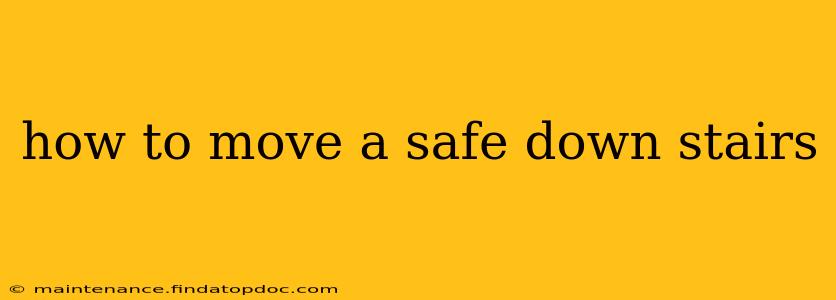Moving a safe, especially downstairs, can be a daunting task. These heavy, often unwieldy objects require careful planning and execution to avoid injury and damage. This guide provides a step-by-step approach to safely move your safe, minimizing risk and ensuring a successful relocation.
Assessing Your Safe and the Staircase:
Before you begin, a thorough assessment is crucial. This involves understanding the safe's weight, dimensions, and any unique features.
- Weigh your safe: Knowing the weight is paramount. Many safes weigh hundreds of pounds, some even exceeding a ton. This will dictate the equipment and manpower needed. If you're unsure of the weight, check the manufacturer's specifications or use a reliable scale.
- Measure your safe: Record its exact dimensions, including height, width, and depth. This will help you determine if it can navigate the staircase's turns and width.
- Inspect your staircase: Take note of the staircase's width, height of each step, and the presence of any obstacles (banisters, narrow landings). Assess whether the staircase is sturdy enough to support the safe's weight. A spiral staircase, for instance, presents a significantly higher challenge.
- Identify potential hazards: Look for loose boards, slippery areas, and inadequate lighting. These could increase the risk of accidents.
Gathering the Necessary Equipment:
Moving a safe requires specialized equipment. Improvising can lead to serious injury.
- Appliance dolly or heavy-duty hand truck: Choose a model with a robust capacity exceeding the safe's weight.
- Moving straps or ratchet straps: These are essential for securing the safe to the dolly and providing stability during transport.
- Furniture sliders: These can help ease the initial movement of the safe across the floor.
- Padding (blankets, towels): Protect the safe's finish and prevent scratches.
- Helpers: You'll absolutely need strong helpers. One person should never attempt this alone. The more helpers, the easier and safer the move will be.
- Protective gear: Gloves, sturdy work boots, and possibly knee pads will protect you from injury.
Planning the Move:
Effective planning is key to a smooth operation.
- Clear the path: Remove any obstacles from the staircase and surrounding areas. Ensure there is ample space to maneuver the safe.
- Determine the route: Carefully plan the route the safe will take down the stairs. Consider the safest and most efficient path, anticipating potential bottlenecks.
- Communicate with your team: Establish clear communication with your helpers. Everyone should understand their role and responsibilities to maintain synchronized movement and avoid accidents.
- Consider professional help: If you are uncomfortable or feel the task is beyond your capabilities, consider hiring professional movers specializing in heavy-object relocation.
Moving the Safe Downstairs:
Proceed slowly and cautiously, prioritizing safety over speed.
- Secure the safe: Use the moving straps or ratchet straps to tightly secure the safe to the appliance dolly or hand truck. Ensure it's balanced and firmly attached.
- Controlled descent: Slowly guide the safe down the stairs, taking one step at a time. Maintain a firm grip on the dolly and communicate with your helpers to coordinate movements.
- Strategic positioning: Use the hand truck's leverage to control the safe's descent, making adjustments as needed to prevent tilting or slipping.
- Rest breaks: Take frequent breaks to prevent exhaustion and reduce the risk of mistakes.
How Much Does it Cost to Move a Safe?
The cost to move a safe varies based on several factors: the safe's weight and size, the distance it needs to be moved, the difficulty of the move (e.g., stairs, tight spaces), and the level of expertise required. It's best to obtain quotes from several professional moving companies specializing in heavy object relocation to get an accurate estimate.
Can I Move a Safe Myself?
While you can attempt to move a safe yourself, it's strongly discouraged unless the safe is exceptionally lightweight and the move is straightforward. The risk of injury and damage to the safe or property is substantially higher without sufficient help and the right equipment. Professional movers possess the expertise, equipment, and insurance to handle such moves safely and efficiently.
What Are the Safety Precautions When Moving a Safe?
Always prioritize safety. Wear appropriate protective gear, ensure adequate help, plan the route carefully, secure the safe properly, and take frequent breaks. If you're uncertain about any aspect of the move, don't hesitate to seek professional assistance.
By following this comprehensive guide and prioritizing safety, you can significantly increase your chances of successfully moving your safe downstairs without incident. Remember, safety should always be the top priority.
